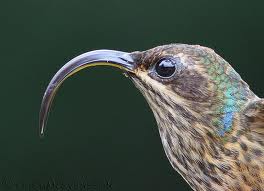Buff-tailed Sicklebill (Eutoxeres condamini)
The Buff-tailed Sicklebill (Eutoxeres condamini) is a species of hermit hummingbird. This hummingbird can be found in the lower Andes of Peru along with the lower Amazonia, along with Colombia, Ecuador and Bolivia. It has a very wide range for a Peruvian hummingbird. Reading about the size of this hummingbird is one thing, but seeing it in person we were surprised at how large this bird was. They typically can get up to 5-6 inches long and weigh anywhere from 8-12 grams!Males and females are virtually identical, differing only in size (especially wing measurements), with the females being some 20% smaller.
Immature birds can be identified by their light-tipped remiges (pinions). They have hardly any blue on the neck and lack the naked crown stripe of the adult.
Range: East Anmdes from Southeastern Colombia, Ecuador to northern Peru.
ID: Longer beak. Abdomen strongly streaked. Bill longer, lower belly much streaked.
(Southern Buff-tailed Sicklebill) Eutoxeres condamini gracilis (Berlepsch; Stolzmann, 1902)
Range: Central Peru (east Andes) and northwestern Bolivia
ID: Shorter beak. Less streaking on the abdomen.
Breeding
Feeding
The upper plumage is an iridescent dull greenish. The under plumage is whitish, strongly streaked with dusky. There is a naked stripe on top of the head, but that stripe is usually concealed. There is a faint blue patch on the neck. The tips of the rectrices (the long flight feathers of the tail) are white.
Immature birds can be identified by their light-tipped remiges (pinions). They have hardly any blue on the neck and lack the naked crown stripe of the adult.
Subspecies
(Northern Buff-tailed Sicklebill) Eutoxeres condamini condamini (Bourcier, 1851)Range: East Anmdes from Southeastern Colombia, Ecuador to northern Peru.
ID: Longer beak. Abdomen strongly streaked. Bill longer, lower belly much streaked.
(Southern Buff-tailed Sicklebill) Eutoxeres condamini gracilis (Berlepsch; Stolzmann, 1902)
Range: Central Peru (east Andes) and northwestern Bolivia
ID: Shorter beak. Less streaking on the abdomen.
Breeding
The female Buff-tailed Sicklebill is responsible for building the remarkable cone-shaped nest the male's only involvement in the reproductive process is the actual mating with the female.One male may mate with several females. In all likelihood, the female will also mate with several males. The males do not participate in choosing the nest location, building the nest or raising the chicks.The nest is often near a stream or waterfall.The average clutch consists of two white eggs.The female alone protects and feeds the chicks she pushes the food down the chicks' throats with her long bill directly into their stomachs. The young are born blind they are brooded only the first week or two, and left alone even on cooler nights after about 12 days the chicks leave the nest due to the small nest size when they are about 20 days old.
Feeding
The Buff-tailed Sicklebills primarily feed on nectar taken from a variety of brightly colored, scented small flowers of trees, herbs, shrubs and epiphytes. They favor flowers with the highest sugar content (often red-colored and tubular-shaped).
Category: Bird-Of-Paradise












0 comments